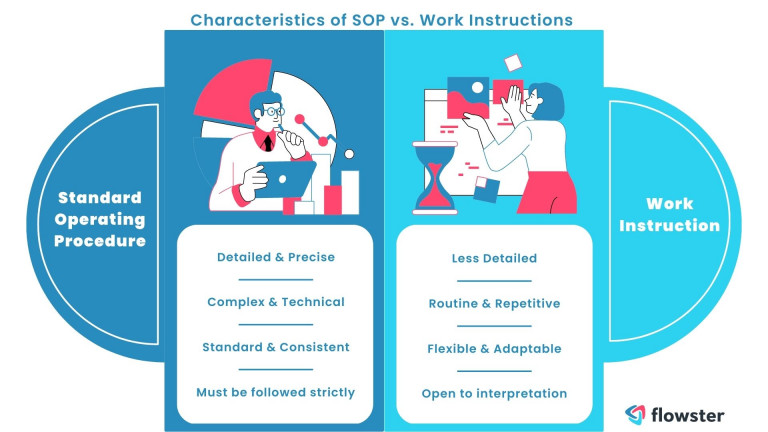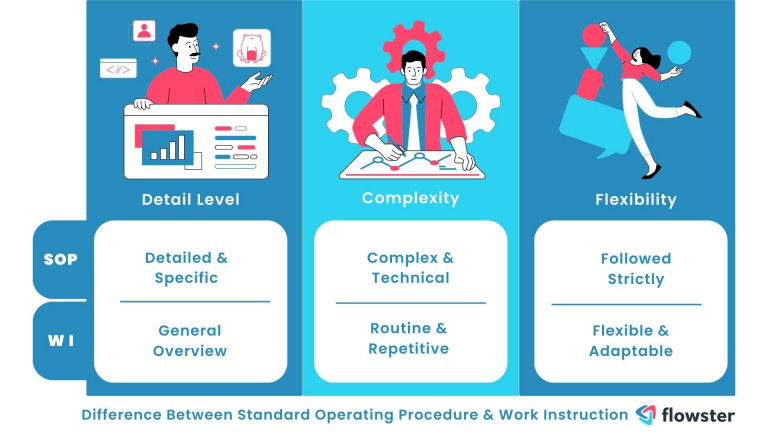When it comes to running a business, there are a lot of technical terms that get thrown around, and it can be tough to keep them all straight. Two of the most common terms that people often get confused about are SOP vs. work instruction.
Although they might seem similar, they are actually different and serve unique purposes. If you’re wondering what the differences are between these two terms, you’ve come to the right place!
In this article, we’ll explore the distinctions between SOPs (standard operating procedures) and work instructions and provide you with practical examples of when to use each.
By the end of this article, you’ll have a clear understanding of the differences between these two terms, which will help you improve the efficiency and productivity of your business. So, let’s dive in!
Article Outline
What is a Standard Operating Procedure?
What is an SOP, you ask? An SOP is a set of instructions that outlines the steps required to complete a specific task.
Essentially, it’s a detailed document that ensures that all employees perform certain tasks consistently and to a predetermined standard. SOPs are often used in complex industries such as healthcare, aviation, and manufacturing, where precision is crucial.
Characteristics of a Standard Operating Procedure
Now, let’s talk about the characteristics of an SOP.
First and foremost, SOPs are incredibly detailed and precise, leaving little to no room for interpretation. They are written for complex and technical tasks that require a high level of expertise and attention to detail.
The primary objective of the processes outlined in an SOP is to ensure consistency and standardization of procedures. As such, they must be followed strictly to guarantee that the desired outcome is achieved.
What is a Work Instruction?
Now that we’ve covered SOPs, let’s dive into work instructions! A work instruction is a document that outlines the steps required to complete a specific task.
Unlike an SOP, a work instruction is intended to be more routine and does not require the same level of detail. Work instructions are commonly used in industries such as retail, hospitality, and food service.
Characteristics of a Work Instruction
Let’s talk about the characteristics of work instruction.
First off, a work instruction is less detailed than an SOP. It provides a more general overview of the task at hand than a step-by-step breakdown.
Work instructions are written for routine and repetitive tasks that do not require the same level of expertise as an SOP.
They are also more flexible and adaptable to individual needs and preferences. This means there is room for interpretation, and employees can use their judgment to complete the particular task at hand.

Difference Between Standard Operating Procedure vs. Work Instruction
Now, let’s dive into the differences between standard operating procedures and work instructions. While they might seem similar, they are actually different and serve two very specific instructions and unique purposes.
Level of Detail
Firstly, SOPs are more detailed and specific than work instructions. SOPs provide detailed instructions and clear guidance on how to perform a task, while work instructions are more general and provide an overview of the task.
Complexity of the Task
Secondly, SOPs are typically used for complex and technical tasks, while work instructions are used for more routine and repetitive tasks. SOPs are necessary in industries where precision is essential, such as healthcare, aviation, and manufacturing.
On the other hand, work instructions are used in industries where tasks are more straightforward, such as retail, hospitality, and food service.
Flexibility
Lastly, work instructions are more flexible and adaptable to individual needs, while SOPs must be followed strictly to ensure consistency and standardization.
This means that there is some room for interpretation with work instructions, and employees can use their judgment to complete tasks. In contrast, SOPs must be followed strictly to ensure quality assurance and that the desired outcome is achieved and consistently implemented.
Overall, understanding the differences between SOPs and work instructions is essential for improving the efficiency and productivity of your business operations.
Knowing when to use each one will ensure that your employees are completing tasks to the appropriate standard and that your business is operating smoothly.

When to Use a Standard Operating Procedure
Knowing when to use an SOP is critical, especially if you’re in an industry where precision and consistency are key. SOPs are typically used for complex and technical tasks that require a high degree of precision and standardization.
Here are some practical examples of when to use an SOP:
Healthcare Procedures
Firstly, SOPs are often used in healthcare to implement standard operating procedures to ensure that patients receive consistent and appropriate care. Healthcare professionals need to follow a set of standardized procedures to guarantee that each patient receives the same level of care.
Aviation Safety Procedures
Secondly, SOPs are necessary for aviation safety procedures to ensure that passengers and crew are safe. In the aviation industry, any deviation from standard procedures and safety protocols can have serious consequences. SOPs are vital for appropriate safety measures, ensuring that all tasks are completed in a timely manner, consistently, and safely.
Manufacturing Processes
Thirdly, manufacturing processes require a high degree of precision to achieve consistent results and guarantee that products are manufactured to the appropriate standard. Any deviation from the standard procedure can result in defective products, which can be costly to the company’s operations.
Laboratory Procedures
Lastly, laboratory procedures require precision and consistency to ensure accurate and reliable results. Any deviation from the standard procedure can affect the accuracy of the results, which can have serious consequences for the research being conducted.
By using SOPs in these industries, businesses can ensure that their employees complete tasks consistently and to a predetermined standard. This improves efficiency, productivity, and ultimately profitability.
When to Use Work Instructions
Work instructions are essential in industries where tasks are more routine and repetitive, and they are designed to ensure that tasks are completed consistently.
Here are some practical examples of when to use work instruction:
Customer Service Tasks
Firstly, customer service tasks can be unpredictable, and they often require employees to think on their feet. Work instructions provide a general overview of the task and allow employees to use their judgment to handle unique situations.
Sales Procedures
Secondly, sales procedures require employees to follow a set of procedures to ensure consistency in the sales process. Work instructions can help employees understand the sales process and provide a general framework to follow.
Inventory Management
Thirdly, inventory management is crucial in ensuring quality control and that a business has the right amount of stock to meet customer demand. Work instructions can provide a clear process for inventory management, ensuring that inventory levels are accurate and products are readily available.
Cash Handling Procedures
Lastly, cash handling procedures are critical to ensuring the safety and security of a business’s finances. Work instructions can provide a clear process for handling cash, ensuring that all cash transactions are recorded accurately and securely.
By using work instructions in these industries, businesses can ensure that tasks are completed consistently and that employees have a general framework to follow. This improves the efficiency of the business and helps to maintain a high level of customer service.
Transform Your Business Processes with Flowster's AI-Driven Automation
SOPs and Work Instructions Made Easy with AI
Artificial intelligence (AI) has revolutionized the way we do business, and it’s no different when it comes to creating your own SOPs and work instructions. AI-automated tools can help create these documents more efficiently and accurately than ever before.
One way that AI can help is by analyzing data to identify patterns and trends. By analyzing data, AI can identify which tasks require an SOP and which tasks require work instruction.
This helps to ensure that the appropriate documentation is created for all personnel involved in each task, improving efficiency and accuracy. Additionally, AI-automated tools can help generate SOPs and work instructions automatically.
By inputting the required information, AI can generate a document that is tailored to the specific task at hand. This saves time and reduces the risk of errors that can occur when creating these documents manually.
Furthermore, AI can also assist in maintaining and updating various guidance documents, SOPs, and work instructions. As tasks change and evolve, these documents need to be updated to reflect the current procedure accurately.
AI can help identify when updates are necessary and even suggest changes to ensure that the document or standard operating procedure remains accurate and up to date.
Flowster’s AI Makes SOPs and Work Instructions Easy
If you’re looking for an AI-automated tool to help create SOPs and create work instructions, we highly recommend trying out Flowster.
Flowster is a workflow and process management app that comes equipped with an AI feature that can help you easily create any SOP or work instruction template.
With Flowster, you’ll be able to streamline your business processes and create documents efficiently and accurately. Plus, the AI feature will save you time by suggesting updates and changes to keep your documents up to date.
Don’t just take our word for it; try Flowster out for yourself! It’s user-friendly, and you’ll see the benefits in no time. Give it a try, and let us know what you think.
FAQs About SOPs and Work Instructions
Is an SOP the same as a policy?
No, an SOP outlines the steps required to complete a specific procedure or task, while a policy outlines a company’s rules and guidelines.
Can work instructions be used in place of an SOP?
It depends on the complexity of the task. Work instructions are suitable for routine and simple but repetitive tasks only; for complex tasks, an SOP is necessary.
Can an SOP be updated?
Yes, SOPs should be reviewed regularly and updated as necessary to ensure compliance and that they remain current and relevant.
Who is responsible for creating SOPs and work instructions?
The responsibility for creating SOPs and detailed work instructions depends on the organization and industry, but it can be the responsibility of management, a dedicated operations team, or individual employees with different functions.
Are SOPs and work instructions necessary for all businesses?
Answer: The need for SOPs and work instructions depends on the industry and the specific tasks being performed. However, even businesses that don’t require them can benefit from standardized procedures to ensure consistency and efficiency.
Conclusion
In conclusion, understanding the differences between SOPs and work instructions is essential for running a successful business. By knowing when to use each one, businesses can improve efficiency, productivity, and ultimately profitability.
Remember that SOPs are necessary for complex and technical tasks that require a high degree of precision and standardization, while work instructions are ideal for more routine and repetitive tasks. They are flexible and adaptable to individual needs, allowing employees to use their judgment to complete the task at hand.
We hope that this article has helped clarify the differences between SOPs and work instructions and provided you with practical examples of when to use each one.
If you have any questions or comments, we’d love to hear from you! Please feel free to share this article with your colleagues and leave a comment below. Thanks for reading!
Ready to create your first SOP or Work Instruction?
Start from scratch to make an automated SOP or workflow template, or look through our templates in Flowster’s Marketplace.
Want help? Use our “Done for You” service to let our experts build custom workflows for you.
Related Articles
Would you like to learn more? See our other informative articles.
Get Free SOP Templates You Can Easily Customize
How Business Process Mapping Helps You Manage and Scale Your Business
AI-Powered Job Task Optimization: How to Future Proof Your Workplace


